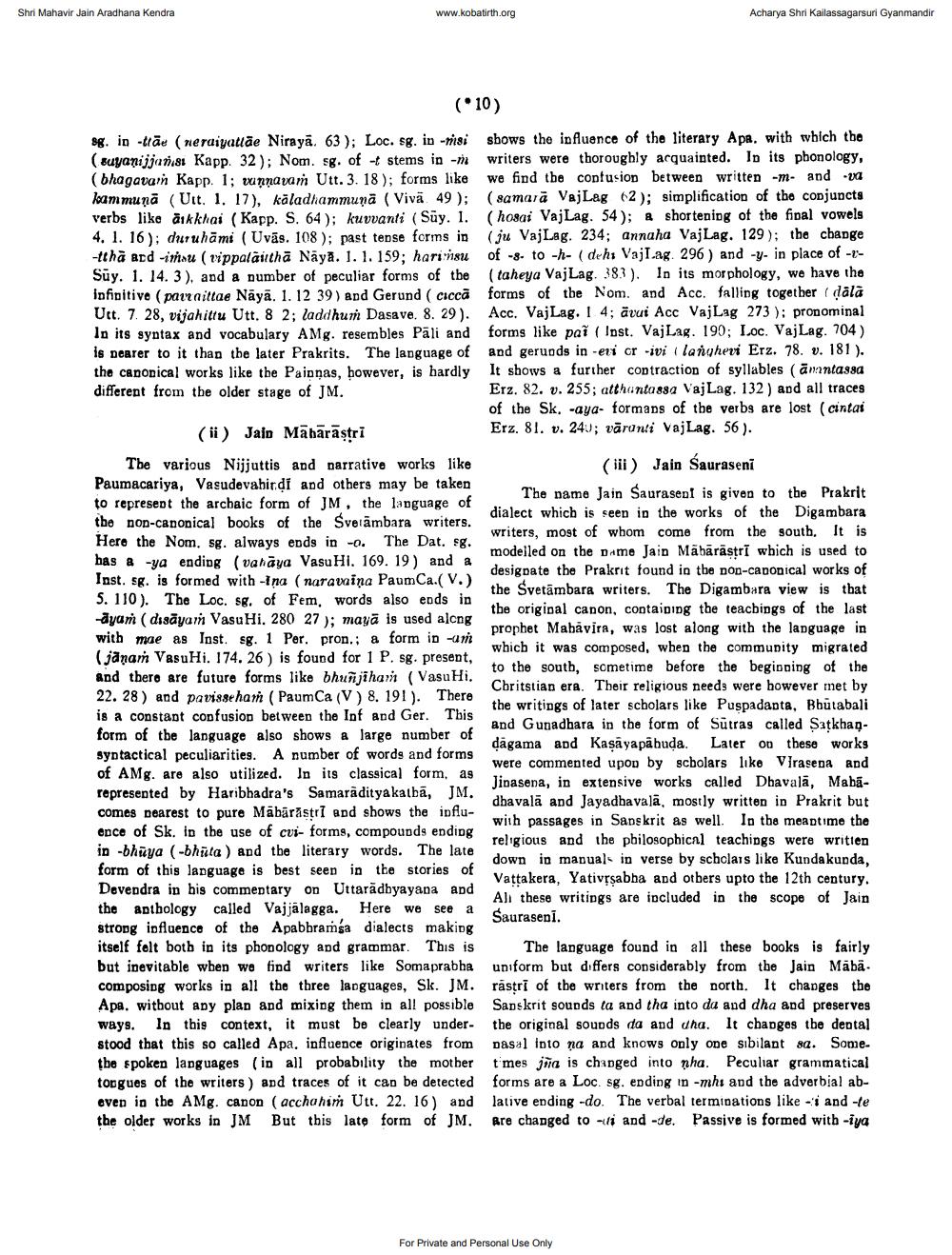________________
Shri Mahavir Jain Aradhana Kendra
www.kobatirth.org
Acharya Shri Kailassagarsuri Gyanmandir
(
10)
sg. in trâu (neraiyatlāe Niraya. 63); Loc. sg. in -msi shows the influence of the literary Apa. with which the
suyanijjan181 Kapp. 32); Nom. sg. of - stems in - writers were thoroughly acquainted. In its phonology, (bhagavam Kapp. 1; wannavam Utt. 3. 18); forms like we find the contusion between written -m- and -va kammunā (Uit. 1. 17), käladhammunā (Vivä 49 ); (samarā VajLag (2); simplification of the conjuncts verbs like äikkhai (Kapp. S. 64); kuvvanti (Süy. I. (hosai VajLag. 54); & shortening of the final vowels 4. 1. 16); duruhāmi (Uvās. 108); past tense forms in (ju Vaj Lag. 234; annaha VajLag. 129); the change -tthā ard -inau ( wippalaithā Nāya. 1. 1. 159; harinsu of -8. to -h- (dehi Vajlag. 296 ) and -y- in place of -rSuy. 1. 14. 3), and a number of peculiar forms of the (taheya VajLag. 383). In its morphology, we have the infinitive (parraittae Nāyā. 1.12 39 ) and Gerund (ciccă forms of the Nom. and Acc. falling together (dala Uct. 7. 28, vijahittu Utt. 8 2; laddhur Dasave. 8. 29). Acc. VajLag. I 4; avui Acc VajLag 273 ): pronominal In its syntax and vocabulary AMg. resembles Pāli and forms like pai ( Inst. VajLag. 190; Loc. Vaj Lag. 704) is nearer to it than the later Prakrits. The language of and geruods in -eri or ivi (langheri Erz. 78. v. 181 ). the canonical works like the Painnas, however, is hardly It shows a further contraction of syllables (anantassa different from the older stage of JM.
Erz. 82. v. 255; atthantassa Vaj Lag. 132 ) and all traces
of the Sk, -aya- formans of the verbs are lost (cintai (ii) Jain Mābārāstri
Erz. 81. v. 240; vāranti VajLag. 56). The various Nijjuttis and narrative works like
(iii) Jain Sauraseni Paumacariya, Vasudevahirdi and others may be taken
The name Jain Saurasenl is given to the Prakrit to represent the archaic form of JM, the language of
dialect which is seen in the works of the Digambara the non-canonical books of the Sverâmbara writers.
writers, most of whom come from the south. Here the Nom. sg. always ends in -o.
It is The Dat. sg.
modelled on the name Jain Maharastri which is used to has & -ya ending (vanāya VasuHi. 169. 19) and a
designate the Prakrit found in the non-canonical works of Inst. sg. is formed with - Ina (naravaiņa PaumCa.(V.)
the Svetambara writers. The Digambara view is that 5. 110). The Loc. sg. of Fem, words also ends in
the original canon, containing the teachings of the last dyan (disāyam VasuHi. 280 27 ); mayā is used along
prophet Mabăvira, was lost along with the language in with mae as Inst. sg. 1 Per. pron.; a form in un
which it was composed, when the community migrated (janam VasuHi. 174. 26 ) is found for 1 P. sg. present,
to the south, sometime before the beginning of the and there are future forms like bhunjihar (VasuHi.
Cbritstian era. Their religious needs were however met by 22. 28) and pavissehan (PaumCa (V) 8. 191). There
the writings of later scholars like Puspadapta, Bhutabali is a constant confusion between the Inf and Ger. This
and Gunadhara in the form of Sutras called Satkhaqform of the language also shows a large number of
dagama and Kasayapabuda. Later on these works syntactical peculiarities. A number of words and forms
were commented upon by scholars like VTrasepa and of AMg. are also utilized. In its classical form, as
Jinasena, in extensive works called Dhavala, Mabarepresented by Haribhadra's Samaradityakatbā, JM.
dhavalā and Jayadbavala, mostly written in Prakrit but comes Dearest to pure Mābārăstri and shows the influ
with passages in Sanskrit as well. In the meantime the ence of Sk. in the use of cui- forms, compounds ending
religious and the philosophical teachings were written in -bhūya (-bhūta ) and the literary words. The late
down in manuals in verse by scholars like Kunda kunda, form of this language is best seen in the stories of
Vattakera, Yativrsabha and otbers upto the 12th century. Devendra in his commentary on Uttaradhyayana and
All these writings are included in the scope of Jain the anthology called Vajjalagga. Here we see a
Sauraseni. strong influence of the Apabbramsa dialects making itself felt both in its phonology and grammar. This is The language found in all these books is fairly but inevitable when we find writers like Somaprabha uniform but differs considerably from the Jain Mābā. composing works in all the three languages, Sk. JM. rastri of the writers from the north. It changes the Apa. without any plan and mixing them in all possible Sapskrit sounds ta and tha into da and dha and preserves ways. In this context, it must be clearly under the original sounds da and uha. It changes the dental stood that this so called Apa, influence originates from Dasal into na and knows only one sibilant sa. Somethe spoken languages (in all probability the mother times jña is changed into nha. Peculiar grammatical torgues of the writers ) and traces of it can be detected forms are a Loc. sg. ending in -mht and the adverbial abeven in the AMg. canon (acchahin Utt. 22. 16 ) and lative ending -do. The verbal terminations like - and -te the older works in JM But this late form of JM. Are changed to vi and -de. Passive is formed with -iya
For Private and Personal Use Only




